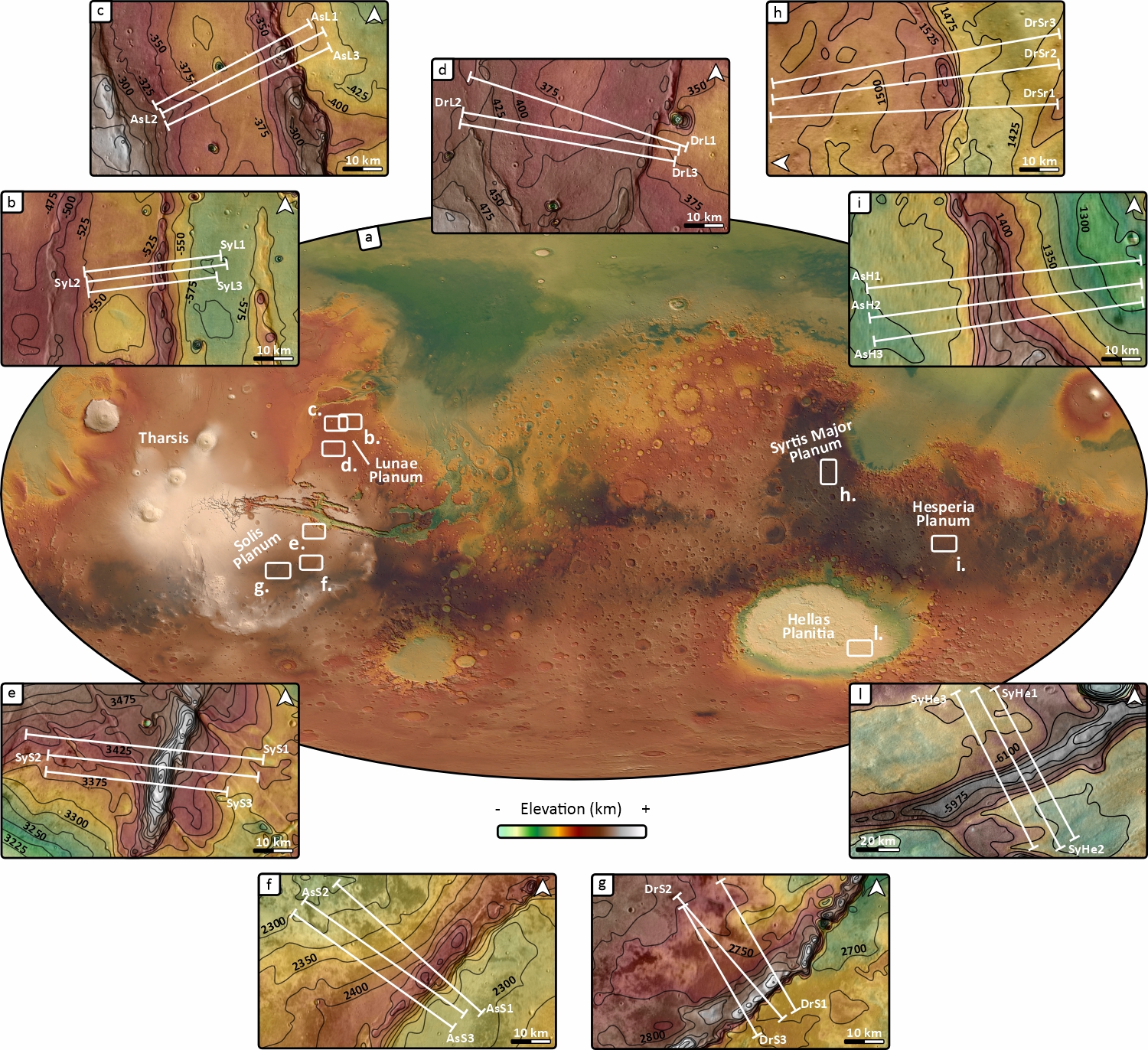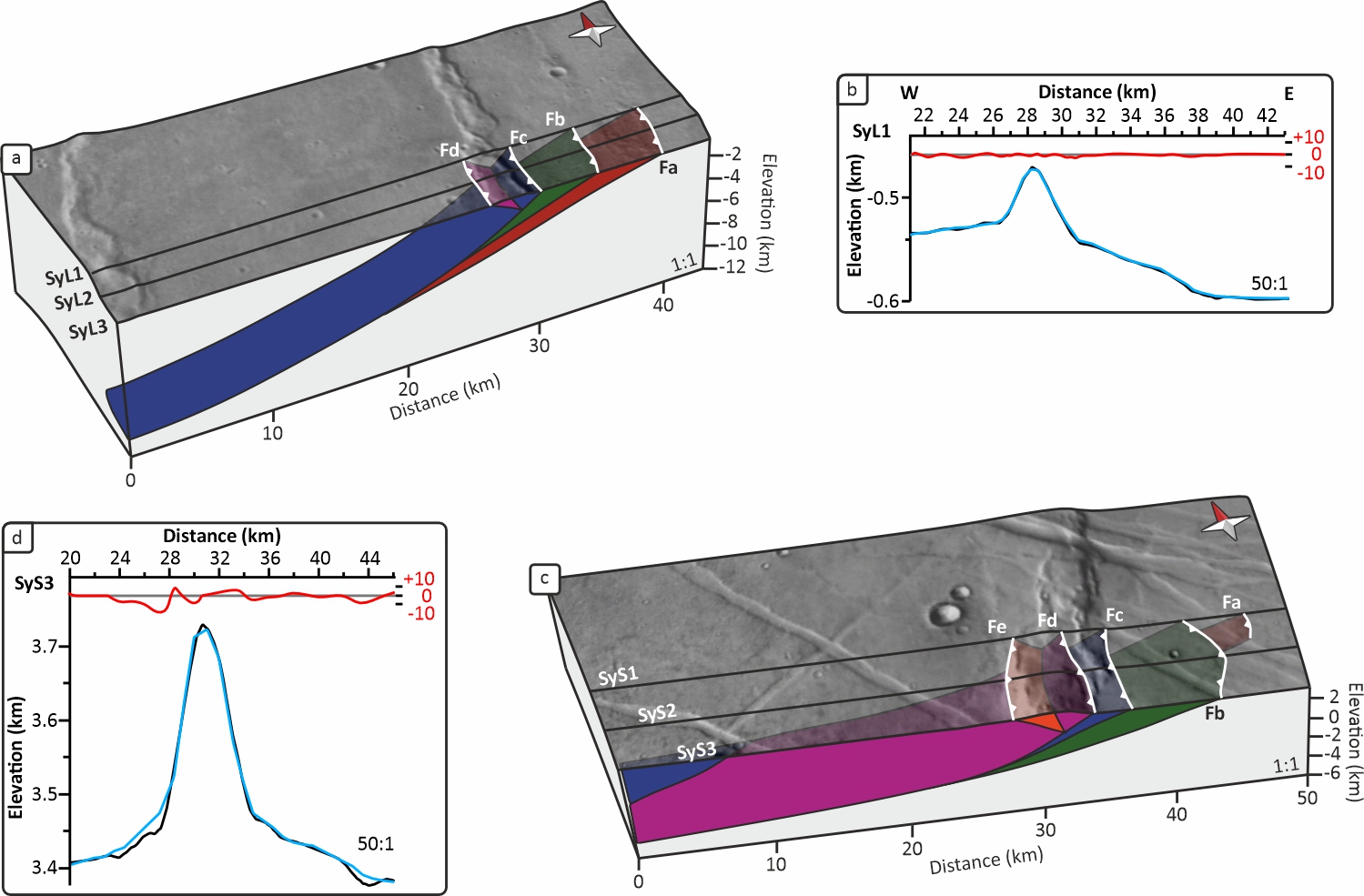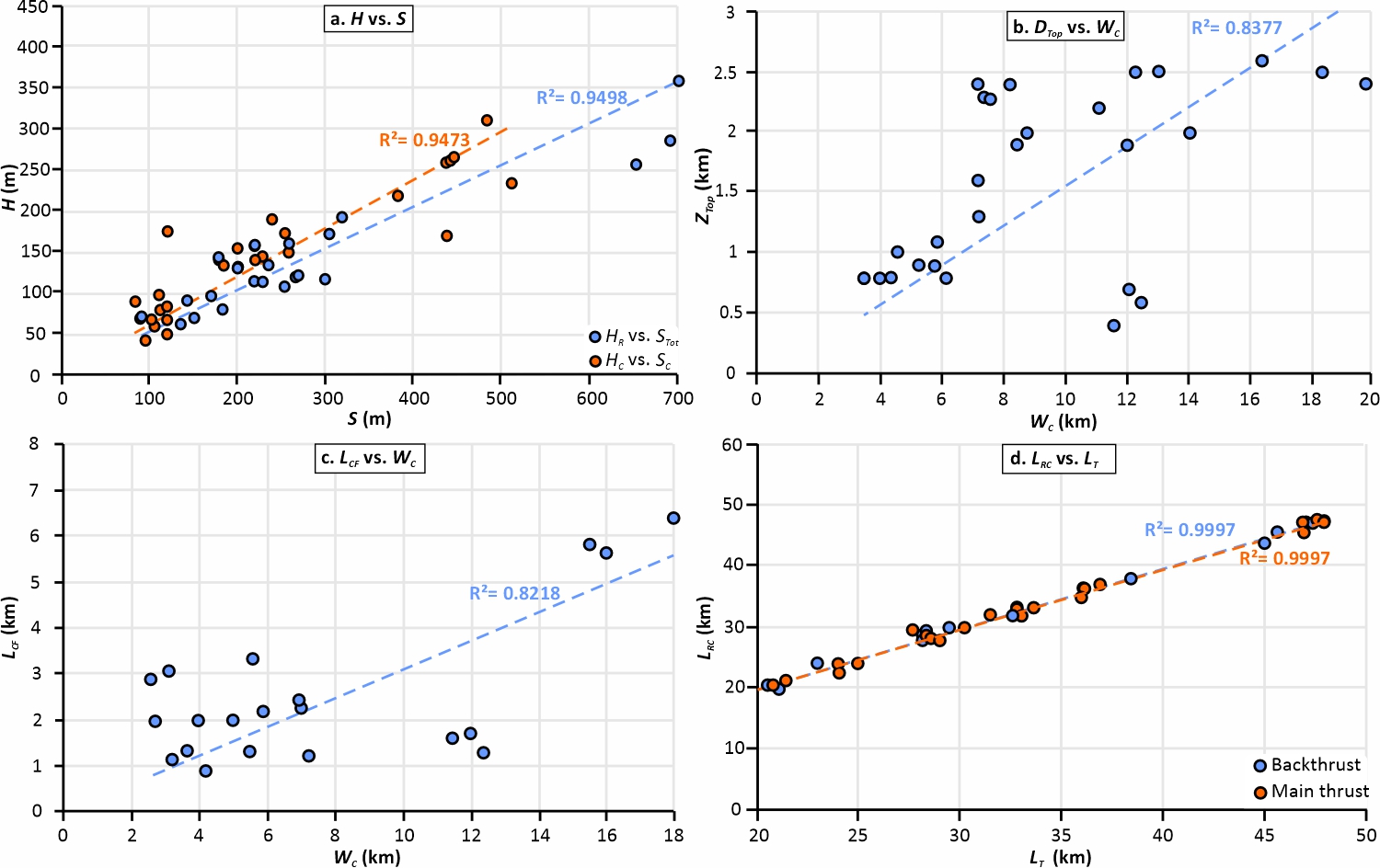Trishear Forward Modelling of WRs on Mars: morphometry and kinematics correlation to unravel Mars geology
- University of Freiburg, Institut für Geo- und Umweltnaturwissenschaften Geologie, Freiburg im Breisgau, Germany (filippo.carboni@geologie.uni-freiburg.de)
Wrinkle ridges (WRs) are among the most prevalent tectonic landforms observed on terrestrial planetary bodies. They are characterized by highly variable, positive relief, which exhibit linear, sinuous, and discontinuous morphologies, sometimes bifurcating or forming en-echelon arrays. They are interpreted as folds overlying blind thrusts, which can reach reliefs of 100’s meters and widths of several 10’s kilometers.
On Mars, WRs typically occur on flood basalt-like units on volcanic plains and within large impact basins. Their analysis can yield valuable insights into the geological evolution of Mars. The structural style of WRs can be used to infer lithospheric strain accommodation, also giving insights onto the mechanical properties of the involved crust.
WRs formation remains a topic of debate with unresolved questions, including: i) geometry and likely structural style of associated blind faults, ii) fault depth, iii) number and role of faults, iv) amount of shortening. Various methodologies have been employed to address these questions, such as elastic dislocation modeling, boundary element modeling, and balancing techniques [1 for a review]. However, these approaches do not completely describe the entire spectrum of observations related to WRs morphometry and kinematics.
In this work, we use the Move software (Petex) to conduct a 3D geometrical reconstruction of a set of WRs, by analyzing and reproducing their morphometric characteristics. We perform a detailed kinematic analysis on nine WRs: six in the circum-Tharsis regions of Lunae Planum and Solis Planum, while further three in Hellas Planitia, Hesperia Planum and Syrtis Major Planum (Fig.1), which underwent different tectonic evolutions.

Fig.1. (a) Map view of the study areas (white squares) and insets (b, e, l) for Symmetric, (c, f, i) for Asymmetric and (d, g, h) for Double ridges WRs.
Adhering to the most recent WR classification proposed by [2], we choose representative examples of each WR type, including symmetric, asymmetric, and double. We prioritize homogeneous topographic data resolution, primarily derived from the Mars Orbiter Laser Altimeter (MOLA). The erosion rates on Mars are constrained between 0.01 to 10 nm/yr [3]. Therefore, by considering areas unaltered by e.g., channels, impact craters, landslides, the topography can be considered as a direct product of deformation.
We apply the Trishear and Fault-Parallel-Flow integrated forward kinematic modelling to model WRs related faults. Trishear allows deformation in the fore-limb of a fault propagation fold, which is confined in a triangular zone radiating from the fault tip, characterized by non-uniform deformation. Within the triangle zone, layer thickness and length can change during deformation, but the area is kept constant [4]. Fault-Parallel-Flow algorithm is a scale-independent method describing how hanging-wall rocks are displaced parallel to the complex fault plane. The methodology allows to model complex fault geometries by assuming area conservation and plane-strain deformation, to determine the fault geometry and kinematics that best fits the observed topography and the measured outcropping faults dip angles.
Our results demonstrate the reliability of the trishear method to model planetary WRs and provide an improvement in understanding Mars’ lithospheric mechanical stratigraphy and WRs kinematics. We demonstrate how the wrinkly and complex nature of WRs can be related to the presence of multiple faults, which accommodate shortening differently (Fig.2).

Fig. 2. 3D model at Lunae Planum (a) and Solis Planum (c). Best-fitting results as true Z difference between modelled and original topography (b, d).
Along the studied asymmetric WRs, the master faults accommodate ca. 60–100% of the total modelled slip, depending on the presence of backthrusts. Along the studied double ridge WRs, characterized by a master fault and a series of smaller backthrusts, the master faults accommodate ca. 40–60% of the total modelled slip. On the symmetric WRs, characterized by a master fault and a main backthrust, the symmetry is given by the master fault and its closest backthrust, whose slip is higher. The master fault and backthrust accrue the 32–54% and the 37–68% of the total modelled slip, respectively. We also model a series of synthetic thrust faults, which promote a further shortening partitioning. Such outcomes may be indicative of an heterogenous mechanical stratigraphy, characterized by multiple shallow detachments, suggested to be likely found within sedimentary interlayers.
The results of the trishear kinematic modelling indicate correlations of the main morphometric parameters of WRs with the geometry and kinematics of the faults (Fig.3).

Fig. 3. (a) Relief (H) vs. slip (S): crest relief (HC) against slip of faults below the ridge (SC), and ridge relief (HR) against slip of all faults (Stot); (b) elevation of fault upper tips (ZTop) against crest width (WC); (c) spacing of the faults below the ridge (LCF) against crest width (WC); (d) ridge crest location (LRC) against location of fault dip change at depth (LT).
The correlations are based on the Ordinary Least Squares Linear Regression, whose quality is represented by the Coefficient of Determination (R2), integrated with residual plots. The good fitting between the parameters can help in a fast correlation between the main morphometric characteristics of WRs with both the geometry and kinematics of the faults at depth. WRs characterized by a higher relief are driven by larger amounts of horizontal along-fault slip, while the broader the width of the main crest, the deeper and more spaced are the faults below the crest (i.e., master fault and possible backthrust). The location of the hinge zone of the main crest, corresponds to the fault dip change at depth. However, the specific depth at which the dip change occurs is not correlated and mainly depends on the dip angle of the upper fault tip, which may vary case by case.
[1] Karagoz, O. et al. (2022). Icarus, 374, 114808. [2] Andrews-Hanna, J.C. (2020). Icarus, 351, 113937. [3] Golombek, M.P. et al. (2006). JGR, 111 (E12S10). [4] Pei, Y. et al. (2014). JSG, 66, 284–297.
How to cite: Carboni, F., Karagoz, O., and Kenkmann, T.: Trishear Forward Modelling of WRs on Mars: morphometry and kinematics correlation to unravel Mars geology, Europlanet Science Congress 2024, Berlin, Germany, 8–13 Sep 2024, EPSC2024-888, https://doi.org/10.5194/epsc2024-888, 2024.